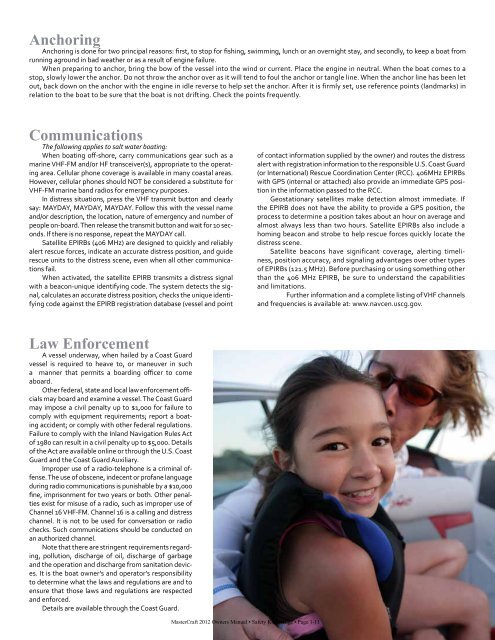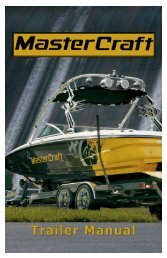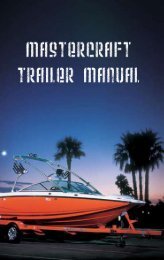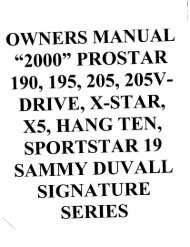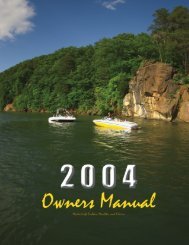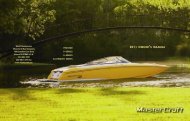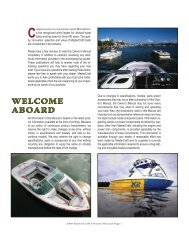2012 MasterCraft Owners Manual
2012 MasterCraft Owners Manual
2012 MasterCraft Owners Manual
Create successful ePaper yourself
Turn your PDF publications into a flip-book with our unique Google optimized e-Paper software.
Anchoring<br />
Anchoring is done for two principal reasons: first, to stop for fishing, swimming, lunch or an overnight stay, and secondly, to keep a boat from<br />
running aground in bad weather or as a result of engine failure.<br />
When preparing to anchor, bring the bow of the vessel into the wind or current. Place the engine in neutral. When the boat comes to a<br />
stop, slowly lower the anchor. Do not throw the anchor over as it will tend to foul the anchor or tangle line. When the anchor line has been let<br />
out, back down on the anchor with the engine in idle reverse to help set the anchor. After it is firmly set, use reference points (landmarks) in<br />
relation to the boat to be sure that the boat is not drifting. Check the points frequently.<br />
Communications<br />
The following applies to salt water boating:<br />
When boating off-shore, carry communications gear such as a<br />
marine VHF-FM and/or HF transceiver(s), appropriate to the operating<br />
area. Cellular phone coverage is available in many coastal areas.<br />
However, cellular phones should NOT be considered a substitute for<br />
VHF-FM marine band radios for emergency purposes.<br />
In distress situations, press the VHF transmit button and clearly<br />
say: MAYDAY, MAYDAY, MAYDAY. Follow this with the vessel name<br />
and/or description, the location, nature of emergency and number of<br />
people on-board. Then release the transmit button and wait for 10 seconds.<br />
If there is no response, repeat the MAYDAY call.<br />
Satellite EPIRBs (406 MHz) are designed to quickly and reliably<br />
alert rescue forces, indicate an accurate distress position, and guide<br />
rescue units to the distress scene, even when all other communications<br />
fail.<br />
When activated, the satellite EPIRB transmits a distress signal<br />
with a beacon-unique identifying code. The system detects the signal,<br />
calculates an accurate distress position, checks the unique identifying<br />
code against the EPIRB registration database (vessel and point<br />
of contact information supplied by the owner) and routes the distress<br />
alert with registration information to the responsible U.S. Coast Guard<br />
(or International) Rescue Coordination Center (RCC). 406MHz EPIRBs<br />
with GPS (internal or attached) also provide an immediate GPS position<br />
in the information passed to the RCC.<br />
Geostationary satellites make detection almost immediate. If<br />
the EPIRB does not have the ability to provide a GPS position, the<br />
process to determine a position takes about an hour on average and<br />
almost always less than two hours. Satellite EPIRBs also include a<br />
homing beacon and strobe to help rescue forces quickly locate the<br />
distress scene.<br />
Satellite beacons have significant coverage, alerting timeliness,<br />
position accuracy, and signaling advantages over other types<br />
of EPIRBs (121.5 MHz). Before purchasing or using something other<br />
than the 406 MHz EPIRB, be sure to understand the capabilities<br />
and limitations.<br />
Further information and a complete listing of VHF channels<br />
and frequencies is available at: www.navcen.uscg.gov.<br />
Law Enforcement<br />
A vessel underway, when hailed by a Coast Guard<br />
vessel is required to heave to, or maneuver in such<br />
a manner that permits a boarding officer to come<br />
aboard.<br />
Other federal, state and local law enforcement officials<br />
may board and examine a vessel. The Coast Guard<br />
may impose a civil penalty up to $1,000 for failure to<br />
comply with equipment requirements; report a boating<br />
accident; or comply with other federal regulations.<br />
Failure to comply with the Inland Navigation Rules Act<br />
of 1980 can result in a civil penalty up to $5,000. Details<br />
of the Act are available online or through the U.S. Coast<br />
Guard and the Coast Guard Auxiliary.<br />
Improper use of a radio-telephone is a criminal offense.<br />
The use of obscene, indecent or profane language<br />
during radio communications is punishable by a $10,000<br />
fine, imprisonment for two years or both. Other penalties<br />
exist for misuse of a radio, such as improper use of<br />
Channel 16 VHF-FM. Channel 16 is a calling and distress<br />
channel. It is not to be used for conversation or radio<br />
checks. Such communications should be conducted on<br />
an authorized channel.<br />
Note that there are stringent requirements regarding,<br />
pollution, discharge of oil, discharge of garbage<br />
and the operation and discharge from sanitation devices.<br />
It is the boat owner’s and operator’s responsibility<br />
to determine what the laws and regulations are and to<br />
ensure that those laws and regulations are respected<br />
and enforced.<br />
Details are available through the Coast Guard.<br />
<strong>MasterCraft</strong> <strong>2012</strong> <strong>Owners</strong> <strong>Manual</strong> • Safety Knowledge • Page 1-11


